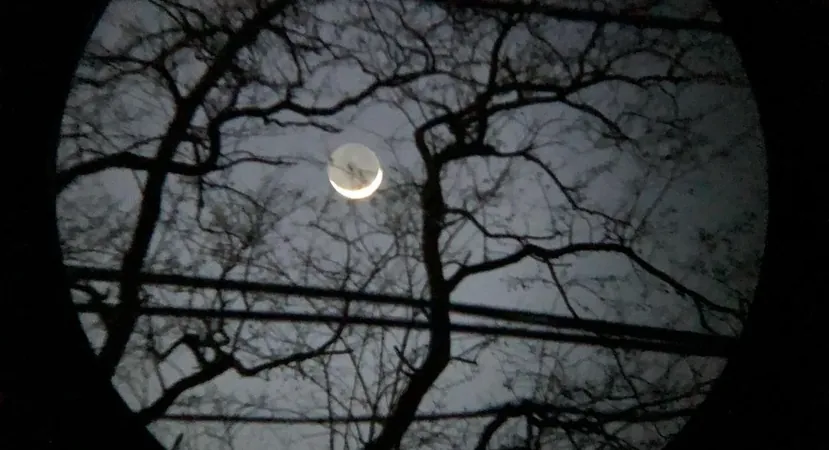
April's Dazzling Night Sky: A Celestial Showdown of Meteor Showers!
2025-03-31
Author: Yan
April's Dazzling Night Sky: A Celestial Showdown of Meteor Showers!
Stargazers are in for an astronomical treat this April, as two dazzling meteor showers will converge in the night sky! From April 20 to April 26, both the Lyrid and Eta Aquarid meteor showers will grace our skies, offering a spectacular display for fans of celestial phenomena.
Lyrid Meteor Shower
The Lyrids meteor shower kicks off on April 17 and reaches its peak on April 22. Enthusiasts can expect to see up to 18 meteors per hour, racing across the sky at around 100,000 miles per hour. These shooting stars, often referred to as "fireballs," can deliver brilliant flashes as they burn up upon entering our atmosphere.
Originating from the debris shed by Comet Thatcher, which orbits the sun every 415 years, the Lyrids appear to radiate from the constellation Lyra, home to Vega, one of the brightest stars visible. "If you enjoy spotting shooting stars, then you won't want to miss this show," says Jackie Faherty, an astrophysicist at the American Museum of Natural History. With the moon in its waning phase, observers can enjoy a clearer view of the meteors without much lunar interference.
Eta Aquarid Meteor Shower
As the Lyrids begin to fade, the Eta Aquarids take center stage, starting on April 20 and continuing through May 21. For six days, both meteor showers will coexist in the heavens. During the peak of the Eta Aquarids, viewers can spot an astonishing 50 meteors per hour, bolting through the night at nearly 150,000 miles per hour. The fast-moving particles showering down are remnants of none other than Halley's Comet, providing an impressive second act to the cosmic spectacle.
"You'll have an overlapping meteor shower, with one exiting and another entering its prime," Faherty explains. It's an incredible opportunity for amateur astronomers and casual stargazers alike.
Messier Marathon and Telescope Events
For those eager to expand their celestial experiences, April is also a prime time for telescope enthusiasts. The month is marked by the traditional "Messier Marathon," a challenge where avid skywatchers aim to spot as many as 110 astronomical objects cataloged by the 18th-century French astronomer Charles Messier. This marathon, a test of endurance and passion for astronomy, usually commences just after sunset, beginning with the Orion Nebula and moving through notable sights such as the Pleiades and Andromeda galaxies.
Moreover, for those in New York City, the Amateur Astronomers Association hosts free weekly telescope viewing events. Every Tuesday from 7 p.m. to 9:30 p.m., visitors can enjoy views at the Highline in Chelsea, and on Friday nights from 7 p.m. to 10 p.m. at Evergreens Cemetery in Brooklyn.
Other Stargazing Opportunities
As the month unfolds, easy naked-eye stargazing opportunities abound. Notably, the Pleiades star cluster will appear near the moon on April 1, setting the tone for the stargazing month. On April 2, Jupiter will shine brightly alongside the moon, while the fiery red planet Mars will be in close proximity on April 5. Between April 10 and 12, Mars will reappear near the moon, forming a delightful celestial line-up with stars Castor and Pollux from the constellation Gemini. "These alignments create stunning visuals and are a must-see for anyone looking to experience the beauty of the night sky," Faherty adds.
Don’t miss your chance to witness this cosmic extravaganza! Grab a blanket and look up to the heavens—you might just be lucky enough to catch a glimpse of some shooting stars lighting up the sky!


 Brasil (PT)
Brasil (PT)
 Canada (EN)
Canada (EN)
 Chile (ES)
Chile (ES)
 Česko (CS)
Česko (CS)
 대한민국 (KO)
대한민국 (KO)
 España (ES)
España (ES)
 France (FR)
France (FR)
 Hong Kong (EN)
Hong Kong (EN)
 Italia (IT)
Italia (IT)
 日本 (JA)
日本 (JA)
 Magyarország (HU)
Magyarország (HU)
 Norge (NO)
Norge (NO)
 Polska (PL)
Polska (PL)
 Schweiz (DE)
Schweiz (DE)
 Singapore (EN)
Singapore (EN)
 Sverige (SV)
Sverige (SV)
 Suomi (FI)
Suomi (FI)
 Türkiye (TR)
Türkiye (TR)
 الإمارات العربية المتحدة (AR)
الإمارات العربية المتحدة (AR)